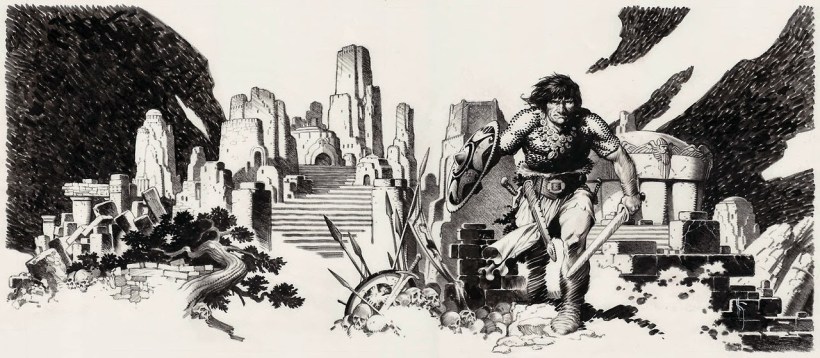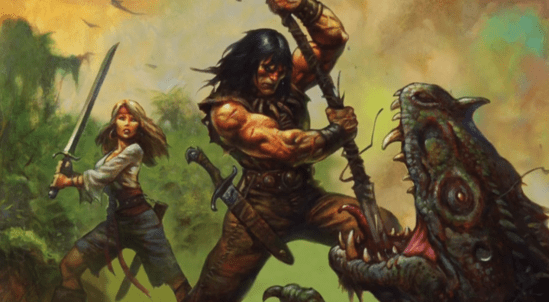 I am writing an article about sword & sorcery.
I am writing an article about sword & sorcery.
Now, mind you, I have written a lot about the genre – a lot of scraps of ideas, scattered here and on my Italian blog, basically me, talking out loud in a vain attempt at putting my ideas in order.
But this time it is different – because I have pitched an article to a learned magazine, and therefore I must write something that will, hopefully, make sense.
I have been through a lot of discussions, in the last few weeks, about the definition of sword & sorcery – and indeed a good friend of mine just posted on his blog a thing called The Definition of Sword & Sorcery (According to Myself), grab yourselves a translation system and check it out, it’s not bad, not bad at all1.
But I still find it extremely unsatisfactory.
And of course it’s just me – so here I am once again talking out loud to myself, trying to give my ideas some order.
You see, I am growing more and more convinced that, if noir is a mode and science fiction is a genre, then sword & sorcery is an attitude, just like hard boiled, and the definition of this attitude is not in a list of ingredients, but in the way you mix them.
What defines sword & sorcery is the world-building.
Now, Wikipedia claims that
Worldbuilding is the process of constructing an imaginary world, sometimes associated with a whole fictional universe.
and goes on to distinguish two different kinds of worldbuilding
In the top-down approach, the designer first creates a general overview of the world, determining broad characteristics such as the world’s inhabitants, technology level, major geographic features, climate, and history. From there, he or she develops the rest of the world in increasing detail. This approach might involve creation of the world’s basics, followed by levels such as continents, civilizations, nations, cities, and towns. A world constructed from the top down tends to be well-integrated, with individual components fitting together appropriately. It can, however, require considerable work before enough detail is completed for the setting to be useful, such as in the setting of a story.
With the bottom-up approach, the designer focuses on a small part of the world needed for his or her purposes. This location is given considerable detail, such as local geography, culture, social structure, government, politics, commerce, and history. Prominent local individuals may be described, including their relationships to each other. The surrounding areas are then described in a lower level of detail, with description growing more general with increasing distance from the initial location. The designer can subsequently enhance the description of other areas in the world. This approach provides for almost immediate applicability of the setting, with details pertinent to a certain story or situation. The approach can yield a world plagued with inconsistencies, however.
OK, first rough idea: sword & sorcery is usually a bottom-up sort of world.
This might explain why sword & sorcery works so well with short fiction: because the author has little time to build a detailed map.
One goes with a few suggestive names – Aquilonia, Shadizar the Wicked – or some striking concepts – The Island of Screaming Statues, the Weeping Solitudes – and then wings it.
If you think about it, great sweeping descriptions of the worlds of sword & sorcery usually assume the tone and style of old legends “Know ye, oh king, that in the time…”.
They are placed at the very beginning of the book, and serve to hoodwink the reader in thinking that a great lot of planning went into the world – but most of all they have to suggest a deep history, deep time (in the geological sense) and to “drag the reader in”.

Most often that’s all the geography and history that we get1 apart from very specific bits… This is the tomb of King Whatsisnameathon, whose reign brought a close to the Third Widdershins Dynasty… look out for spike-filled pits and falling blades…
Maps are drawn afterwards, maybe because there is a young fan pestering you via mail.
There is this sense of uncertainty, of ink bleeding at the borders of the map, in the way the greater world is presented.
OK, son this is the world… more or less. The map is a bit old, was drawn by a blind monk, distances are probably not to scale.
Maybe this is the reason why sword & sorcery characters are so often outsiders – because it’s damn hard being an insider in a world that’s so sketchy and uncertain.

Worldbuilding of course is not just geography – it is also physics, history, natural sciences…
When designing a world we must set down the house rules, and the house rules of sword & sorcery are very specific to the genre.
Like the supernatural, that is commonplace and yet scary.
But see, once again I am doing a list of ingredients.
I’ll have to think about it a little more – but the deadline looms closer and closer, and these are the ideas I am juggling.
Any idea or suggestion?

13 September 2016 at 19:09
You just described the way I do world building in my games. So maybe sword and sorcery is a writing METHOD 😉 ? Build bottom up, little by little, with a character who is a bit of an outsider like the reader, because not everyone has the time, patience and dedication to write a Silmarillion before the swords start to clash and spells are cast 🙂
LikeLiked by 1 person
13 September 2016 at 19:37
Yes, that’s my idea exactly – it’s a way to set up your working routine, optimizing time, and playing fast and loose.
LikeLike
14 September 2016 at 04:03
Yup, I think this approach also works very well for me, specially in combination with Gemmell’s technique of “stick a character on a horse and drop him somewhere, then see what happens.”
LikeLiked by 1 person
14 September 2016 at 08:43
It’s a technique that, I think, comes from the old pulps – a variation on “put a character on top of a tree, set the tree on fire, have stones rain on him from the sky” 🙂
And yet it’s not that it takes less planning than,say, high fantasy… it just takes a different kind of planning.
I think.
LikeLike
14 September 2016 at 04:29
I’d love to help, but it’ll take a bit of thought. I know hardly anything about sword and sorcery — I certainly couldn’t advise anybody on how to write it — and I DO write it!!! When it comes to world building, I generally cheat. Certainly with my main series — Felimid the bard in the sixth century, Kamose the Magician in ancient Egypt, reign of Rameses III. I use the real world. Somehow it makes the fantastic events seem more grounded and believable, and kind of imposes discipline. I’ve only attempted actual world building a couple of times, both with the bottom-up approach. But. I look forward to your article. And I’ll try to think of something more useful to offer!
LikeLiked by 1 person
14 September 2016 at 08:48
I found out this is a common situation – we write it, and we love reading it, and we know exactly what it’s like, but basically we can’t put down a sword & sorcery “formula” or one-size-fits-all definition.
And by the way, I like it like that!
And I also cheat, writing historical sword & sorcery – Aculeo & Amunet operate in the Third Century AD, and the fantasy elements are somewhat “fringe” elements… like in H.P. Lovecraft, there’s a hidden, pretty scary world. And I agree, it makes the stories more grounded – and not always easier to write (lots of research, lots of documentation).
LikeLike
15 September 2016 at 10:20
Reblogged this on Hero Engine and commented:
Talking about Sword & Sorcery: a great article by Davide Mana!
Two months have passed since the last post of this blog. I am very sorry about this gap, but I had to “focus on production”, as one of my publishers always says. And I had to sacrifice the divine art of blogging, in Italian and English, on the altar of writing. This way, in a few months I completed three books and a great amount of short fiction… new stuff to talk about here, soon.
Then… in the meantime in Italy, we have had a “Sword & Sorcery Renaissance” (sort of), with a new movement of writers and publishers working on different projects (remember the short fiction I was talking about?).
What can Italian writers add to the Sword & Sorcery genre, in this decade? Italian Sword & Sorcery movement is working in continuity with the great US writers of the last century but with a new-pulp attitude, and with “Italian-Mediterranean” settings and mood, the latter two as THE elements that can distinguish our ideas and writings from everyone else.
So… my friend and colleague Davide Mana, blogger and writer very much better than me (I have to admit this), is part of this “movement” too and wrote down something interesting on the matter, after a long time discussion we have had on our blogs and in the Italian S&S website…
This is what he think on Sword and Sorcery!
LikeLike